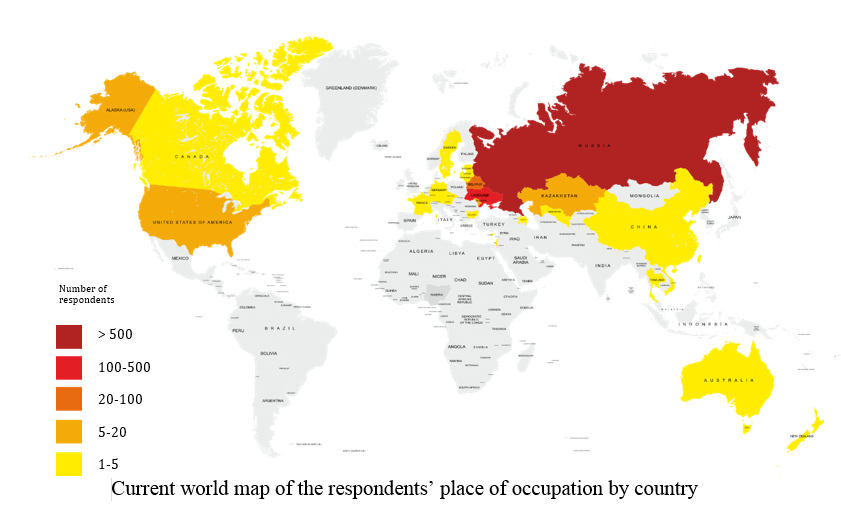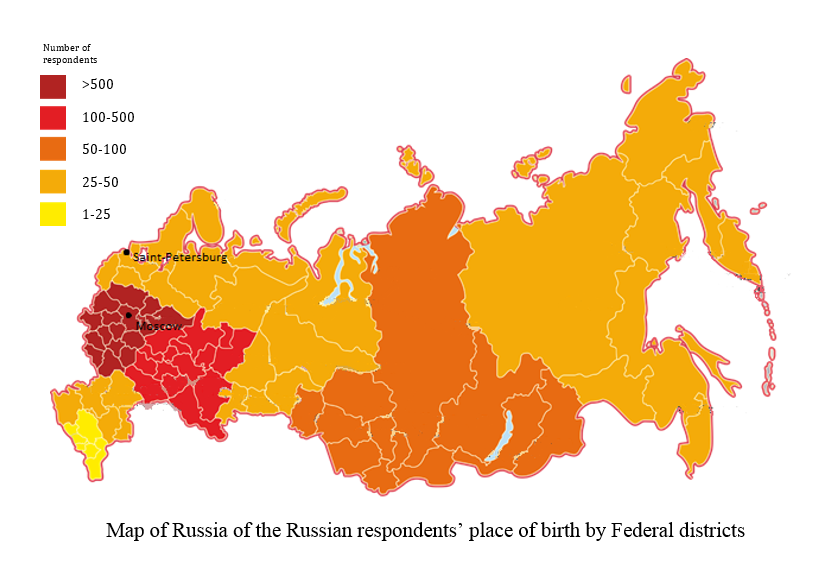What are we learning? Study on the importance of IT competencies
Good day to all! In November 2013, we conducted a study on the importance of certain IT competencies. Many thanks to all who answered our questionnaire!
Today we publish the results of our research in full:
Our questionnaire consisted of three main sections:
1. Information on current employment and professional experience
2. Assessment of IT competencies
3. Information on age, gender, country of birth, country of study and country of current residence
In total, we received over 1,600 responses from respondents, of whom 980 completed answers were selected (in which the first, second and third sections were completed). Among the respondents were 68 school students and 38 professionals with international IT experience. The figure below shows the main categories of our respondents.

Interesting statistics turned out in the context of the age structure of our survey. The graph below shows data on the age of participants who wished to indicate their age - 93 percent. The most active group of respondents is young IT specialists aged 23-26 years. With a high probability, this fact is largely due to the specifics of those professional network communities (including Habr), in which we actively informed about the conducted research.

It was also interesting to find out what our youngest survey participants think about the importance of IT competencies. High school students talked about the skills they would need to become successful IT professionals:
... know programming languages ...
... know HTML ...
... be experienced ...
... have experience in creating websites ...
... have the opportunity to work with experts to learn from them ....
We were encouraged that high school students in general demonstrated a similarity of opinions in terms of assessing importance with older groups, including those representatives of government, heads of large companies and scientists we interviewed.
')
No less interesting conclusions from the survey conducted related to the representation of the fair sex in the IT industry in the context of different age groups. In total, the representation of women in our survey was 10%. The figure below illustrates the distribution of girls in IT in different groups.

More than 30 percent of schoolgirls in high school are interested in the field of information technology. By “interest” we mean that they attend additional electives in computer science and programming. In addition, such classes (as a rule) require additional expenses, which implies that parents support their daughters' interest in IT.
However, the relative representation of girls is significantly reduced at the university level. Only 10% of them study in the field of information technology. Later, the share remains unchanged - students successfully receive education and continue to work in the sector. The temporary decline in representation in statistics between the ages of 30-35 is also quite explicable - we assume that this is due to the birth and upbringing of children. The absence of women in the older age group can be explained by the relative “youth” of the IT professions in general. But where are the remaining two thirds of girls who want to go to universities for IT specialties? This is a very interesting question that will require additional research.
Many participants gave us their place of birth, place of education and current job location. Based on these data, we have compiled migration maps of IT specialists in the world and within Russia. At the same time, all our respondents who participated in the survey were born within the limits of the former USSR, see the figures below.


At the same time, the location of current work varies considerably and we noted that about 3.9% of respondents emigrated outside the former Soviet Union (figure below). These data closely correspond to the official statistics on migration abroad - 3.6% from 1991 to 2007 (Palnikov, 2007). Indeed, Russian specialists are always in demand by the largest companies in the IT industry.
The maps below show the movement of respondents living in Russia. We note a noticeable trend here in the movement of IT specialists from all regions of Russia to the Northwestern and Central Federal Districts. It is interesting to note that the concentration of professionals of the sector in the Volga district, including Tatarstan, does not change significantly, and in density it is inferior only to the leading Central district. This means that this region is very attractive economically and socially for IT professionals.


And finally, below we present the summarized results on the assessment of the importance of the competencies themselves. In general, all the competencies offered by us were assessed by the participants as important. This is a very optimistic conclusion, meaning that all our target audiences share similar professional values. In addition, it emphasizes the relevance of the choice of these values by the University of Innopolis as a guide when drawing up their own curriculum.

Says Anton, a 3rd year student at the Moscow Institute of Physics and Technology: “I believe that the basic skills are having a structured mindset. This is the first. Secondly, a specialist must have a very large mathematical base, because all programming is based in varying degrees on mathematics. The main quality of the programmer is the ability to invent new algorithms, and not to look for the ones already used. When it comes to programs that nobody has written before you, then that very moment comes when programming turns from a dry activity into creativity, and you need to come up with something new, introduce, roughly speaking, something in your world. ” .
In terms of individual competencies, we saw that the importance of Subject Knowledge (Disciplinary Knowledge) is highly appreciated by company leaders, representatives of government agencies and the scientific community, and to some extent underestimated by representatives of other categories. We noted that specialists tend to underestimate the importance of knowledge of fundamental disciplines, while top managers note the high importance of this competence. The knowledge of key professional tools in this case is estimated by specialists somewhat higher than by managers.
Today we publish the results of our research in full:
Our questionnaire consisted of three main sections:
1. Information on current employment and professional experience
2. Assessment of IT competencies
3. Information on age, gender, country of birth, country of study and country of current residence
In total, we received over 1,600 responses from respondents, of whom 980 completed answers were selected (in which the first, second and third sections were completed). Among the respondents were 68 school students and 38 professionals with international IT experience. The figure below shows the main categories of our respondents.

Interesting statistics turned out in the context of the age structure of our survey. The graph below shows data on the age of participants who wished to indicate their age - 93 percent. The most active group of respondents is young IT specialists aged 23-26 years. With a high probability, this fact is largely due to the specifics of those professional network communities (including Habr), in which we actively informed about the conducted research.

It was also interesting to find out what our youngest survey participants think about the importance of IT competencies. High school students talked about the skills they would need to become successful IT professionals:
... know programming languages ...
... know HTML ...
... be experienced ...
... have experience in creating websites ...
... have the opportunity to work with experts to learn from them ....
We were encouraged that high school students in general demonstrated a similarity of opinions in terms of assessing importance with older groups, including those representatives of government, heads of large companies and scientists we interviewed.
')
No less interesting conclusions from the survey conducted related to the representation of the fair sex in the IT industry in the context of different age groups. In total, the representation of women in our survey was 10%. The figure below illustrates the distribution of girls in IT in different groups.

More than 30 percent of schoolgirls in high school are interested in the field of information technology. By “interest” we mean that they attend additional electives in computer science and programming. In addition, such classes (as a rule) require additional expenses, which implies that parents support their daughters' interest in IT.
However, the relative representation of girls is significantly reduced at the university level. Only 10% of them study in the field of information technology. Later, the share remains unchanged - students successfully receive education and continue to work in the sector. The temporary decline in representation in statistics between the ages of 30-35 is also quite explicable - we assume that this is due to the birth and upbringing of children. The absence of women in the older age group can be explained by the relative “youth” of the IT professions in general. But where are the remaining two thirds of girls who want to go to universities for IT specialties? This is a very interesting question that will require additional research.
Many participants gave us their place of birth, place of education and current job location. Based on these data, we have compiled migration maps of IT specialists in the world and within Russia. At the same time, all our respondents who participated in the survey were born within the limits of the former USSR, see the figures below.


At the same time, the location of current work varies considerably and we noted that about 3.9% of respondents emigrated outside the former Soviet Union (figure below). These data closely correspond to the official statistics on migration abroad - 3.6% from 1991 to 2007 (Palnikov, 2007). Indeed, Russian specialists are always in demand by the largest companies in the IT industry.
The maps below show the movement of respondents living in Russia. We note a noticeable trend here in the movement of IT specialists from all regions of Russia to the Northwestern and Central Federal Districts. It is interesting to note that the concentration of professionals of the sector in the Volga district, including Tatarstan, does not change significantly, and in density it is inferior only to the leading Central district. This means that this region is very attractive economically and socially for IT professionals.


And finally, below we present the summarized results on the assessment of the importance of the competencies themselves. In general, all the competencies offered by us were assessed by the participants as important. This is a very optimistic conclusion, meaning that all our target audiences share similar professional values. In addition, it emphasizes the relevance of the choice of these values by the University of Innopolis as a guide when drawing up their own curriculum.

Says Anton, a 3rd year student at the Moscow Institute of Physics and Technology: “I believe that the basic skills are having a structured mindset. This is the first. Secondly, a specialist must have a very large mathematical base, because all programming is based in varying degrees on mathematics. The main quality of the programmer is the ability to invent new algorithms, and not to look for the ones already used. When it comes to programs that nobody has written before you, then that very moment comes when programming turns from a dry activity into creativity, and you need to come up with something new, introduce, roughly speaking, something in your world. ” .
In terms of individual competencies, we saw that the importance of Subject Knowledge (Disciplinary Knowledge) is highly appreciated by company leaders, representatives of government agencies and the scientific community, and to some extent underestimated by representatives of other categories. We noted that specialists tend to underestimate the importance of knowledge of fundamental disciplines, while top managers note the high importance of this competence. The knowledge of key professional tools in this case is estimated by specialists somewhat higher than by managers.
Source: https://habr.com/ru/post/212925/
All Articles